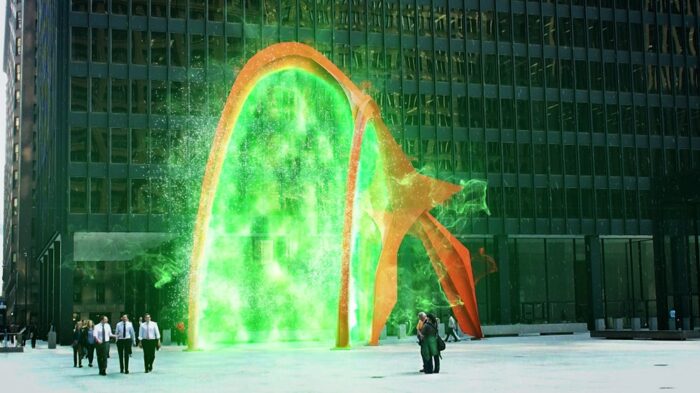ตอนที่สี่ในซีรีส์ “มุมมอง Metaverse” (ตอนเก่า Epic, Unity, Snap) คราวนี้เรามาดูมุมมองจาก Niantic Labs เจ้าพ่อแห่งวงการ AR บนมือถือ ผู้สร้างชื่อจาก Pokemon Go กันบ้าง
บทสัมภาษณ์ John Hanke ผู้ก่อตั้งและซีอีโอของ Niantic ออกมาตั้งแต่เดือนธันวาคม 2021 ซึ่งมาเขียนวันนี้ก็ไม่ค่อยเป็นจังหวะที่เหมาะเท่าไร เพราะ Niantic ประกาศปลดคนพอดี
มุมมองของ John Hanke ต่อคำว่า Metaverse ก็คาดเดาได้ไม่ยาก ว่าในฐานะที่บริษัทของเขาทำธุรกิจ AR มุมมองของเขาย่อมแตกต่างจากนิยามของ Meta ที่เน้นอวตาร VR อยู่พอสมควร (และพลอยให้มุมมองของ Hanke ค่อนข้างคล้ายกับของ Snap เพราะเป็นธุรกิจ AR เหมือนกัน)
Hanke บอกว่าโลกในปี 2021 อาจตื่นเต้นกับคำว่า Metaverse กันมากไปนิด เพราะใช้ชีวิตแบบล็อคดาวน์กันมานาน เลยพลอยจินตนาการไปว่า ต่อจากนี้ไปพวกเราต้องอยู่ในโลก 3D กันสินะ
I felt like a lot of people were maybe a little bit overly influenced by what we all endured during COVID, which is to say: spending a lot of time at home, a lot of time on Zoom, kids going to school remotely, watching kids spend a ton of time on Roblox, binging on Netflix, getting delivery food, the whole thing. A lot of these products saw a big lift from COVID. I mean, let’s be honest, people were spending a ton more discretionary time and energy in these worlds. I think that fed a level of frenzy around thinking that the “metaverse” is the future and that we’re all going to live in these 3D worlds.
เขายังบอกว่าอ่านนิยายของ Neal Stephenson กับ William Gibson มานานแล้ว จึงรู้ดีว่าฉากจบของนิยายคือ ตัวละครต้องหนีออกมาจาก Metaverse VR เพราะมันไม่ใช่โลกที่พึงปรารถนา
แต่ในทางกลับกัน AR คือเทคโนโลยีที่ช่วยพาคนออกไปเจอคนอื่นบนโลกจริงๆ และทำให้เรารู้จัก เรียนรู้ สถานที่รอบตัวให้มากขึ้น
I’m a techno-optimist in the sense that I think AR — a real-world version of that metaverse, if you will, that’s about getting people outside and active and learning about their city, state, town — can help bring us back together. It can help us get reconnected with our communities and the places that we live.
เขายังเปรียบเทียบความเหมือน-ต่าง ระหว่าง AR กับ VR ว่ามันมีส่วนที่เหมือนกัน คือเทคโนโลยีฝั่งซอฟต์แวร์ที่ใช้ปฏิสัมพันธ์กับวัตถุเสมือน และฝั่งฮาร์ดแวร์ที่ต้องใช้แว่นสวมหัวเพื่อแสดงผล 3D มีหน่วยประมวลผลและชิ้นส่วนต่างๆ ที่ย่อให้เล็กลง
AR and VR have a lot of shared features. Our Lightship platform is about infrastructure that can allow millions of people to share what you’re interacting with in the game world, which is overlaid on the physical world. You can message back and forth to one another. I can get updates whenever you change something in the world. Similar technologies are needed for the VR version of the metaverse.
Likewise, some of the tech for AR glasses and VR glasses, there’s a lot of overlap there in terms of a head-worn device, and you have to miniaturize a bunch of stuff. You have to do 3D. You have to have sensors that track where your head’s pointed and various things like that.
แต่สิ่งที่เหลือนั้นต่างกันไปเลย เพราะ VR คือการย้ายเข้าไปอยู่ในโลกเสมือน ที่ตัดขาดออกจากโลกภายนอกอย่างสิ้นเชิง และการพาคนที่นั่งอยู่ด้วยกันเข้าไปอยู่ในโลก VR พร้อมกันเป็นสิ่งที่ทำได้ยาก
VR is a sedentary process where you’re going to slip into this virtual world. You are going to be cut off physically from people who are in your vicinity. You’re at home on the couch with your significant other or other family members. Are you going to really want to be in VR? Are you going to have the four of you lined up there all in your headsets? Maybe you have an avatar representation of other people, but it’s fundamentally a poor substitute for the real human-to-human interaction.
ส่วน AR นั้นกลับกัน เพราะเป็นการเสริมข้อมูลเข้าไปยังโลกจริงๆ ที่เราอาศัยอยู่ ให้เราสนุกขึ้น (เกม) หรือมีข้อมูลประกอบการตัดสินใจมากขึ้น (แผนที่บอกทาง) โดยที่เรายังมีปฏิสัมพันธ์กับคนอื่นๆ รอบตัวอยู่เหมือนเดิม ไม่ได้มาแทนโลกจริงๆ แบบ VR
AR is about getting out of your way as much as possible with the technology. If it’s a wearable device like a watch, something in your ear, or eyeglasses, AR is about giving you information. Maybe it will help you have fun playing a game, going on a secret treasure hunt out in the world, and finding pokémon. Maybe it just tells you how to get there: painting arrows on the ground, showing you where the subway is. Maybe it shows you the menu of the restaurant you’re standing in front of before you walk through the door. Maybe you tap on a virtual UI to make a reservation or check into the airport. It’s about being helpful, but allowing you to primarily exist in the world as a full-blown, involved human being: using all your senses, enjoying being out in that environment, and probably hanging out with other people in the real world. But AR is just trying to make that experience better, not cutting you off and replacing it. That’s the big distinction.
เขายังวิจารณ์แนวคิดอวตารว่าไม่เวิร์คหรอก ต่อให้เป็นอวตารที่เหมือนตัวเราจริงๆ เช่น การสแกนร่างกายมาเลย ก็ไม่เวิร์คอยู่ดี เหตุผลก็คือเวลาคนเรามีปฏิสัมพันธ์กัน มันไม่ได้เพียงแค่เห็นภาพและได้ยินเสียงกันเท่านั้น แต่ส่วนอื่นๆ ของร่างกายก็ยังมีปฏิกิริยาต่อกันด้วย การเอาจอภาพมาแปะตาแล้วหลอกตัวเองว่าเรากำลังเจอกันจริงๆ มันจึงแทนประสบการณ์จริงไม่ได้ทั้งหมด
I would argue strongly that a visual representation of an avatar — even if it’s a really photorealistic avatar — doesn’t do that.
Your body senses the world and other people in a very broadband way: eyes and ears. When human beings are together over time, your heartbeats and the frequency of your brainwaves will actually synchronize.
To think that we can just put two OLED displays in front of our eyes and believe that we’re replicating all that comes from those real interactions just isn’t true. That experience is sipping through a soda straw in terms of the bandwidth with which you’re going to perceive the environment and other people.
เขายังบอกว่าแกนหลักของ AR ไม่ใช่การแสดงผลบางอย่างขึ้นมาบนจอของมือถือ ซึ่งเป็นแค่เสี้ยวหนึ่งของ AR เท่านั้น แต่แกนหลักของมันจริงๆ คือการรู้ตำแหน่งและทิศทางที่ผู้ใช้งานหันไปในตอนนั้น ซึ่ง Niantic มีเทคโนโลยีและข้อมูลแผนที่เรื่องนี้จาก UGC ในเกม (นั่นคือแพลตฟอร์ม Lightship)
The big linchpin for that is not the visual part of AR in the sense of just overlaying a hologram into the scene, but knowing where you are in the world and where your gaze is directed, precisely. We can get an approximate location from GPS. You can get a really bad orientation from the compass that you have on your phone device. The calculations are off by 10 meters in a GPS — and if you’re in an urban situation, possibly even more — so the compass gets really confused.
If you’ve ever had that experience of coming out of a subway station and trying to orient yourself, you walk a block before you realize you’re going in the wrong direction. There’s an AR map that lets a camera know exactly what it’s looking at in the world so that you can make the pokémon hide behind the park bench

/cdn.vox-cdn.com/uploads/chorus_asset/file/23080992/VRG_ILLO_Decoder_John_Hanke_s.jpg)